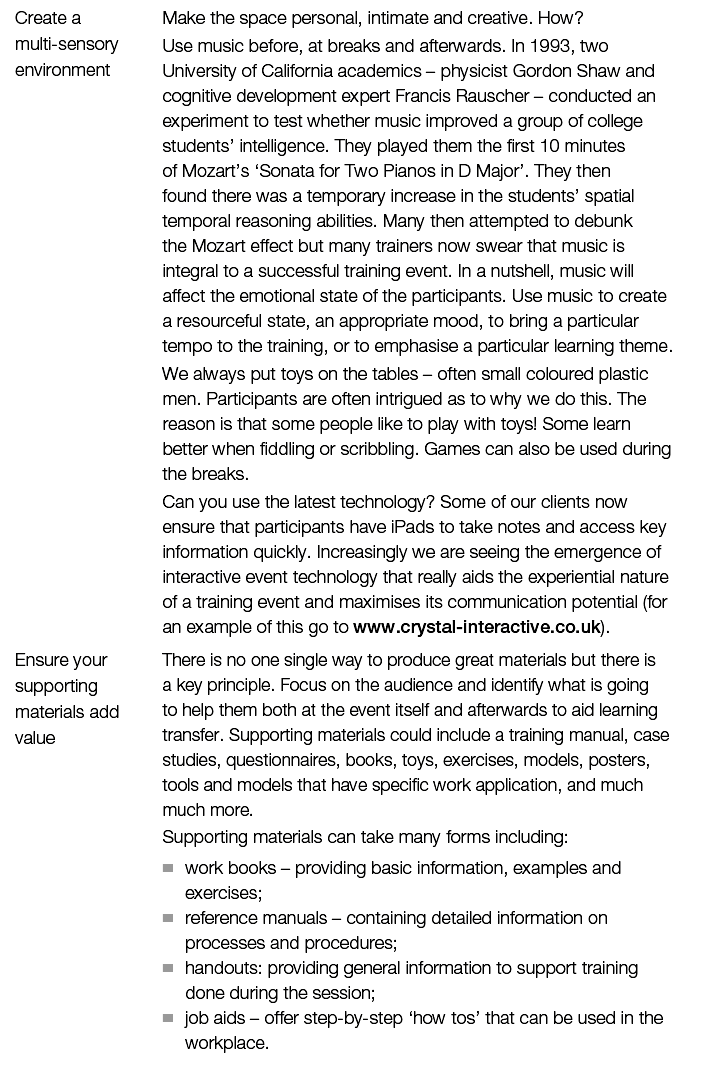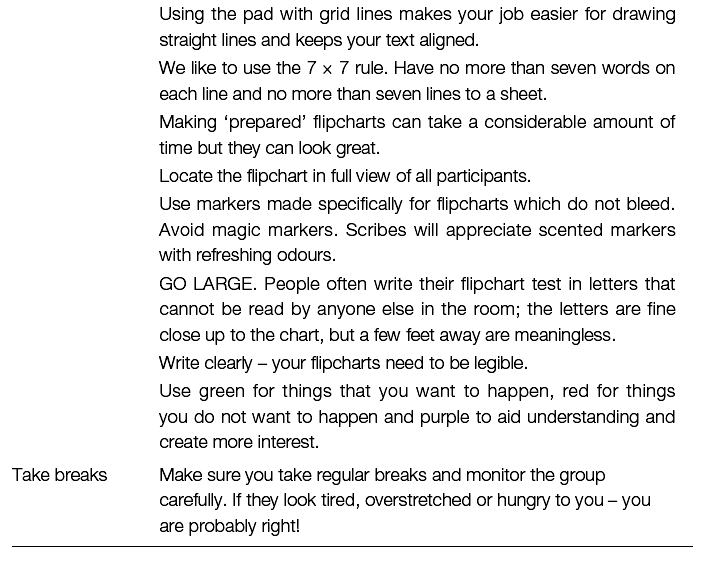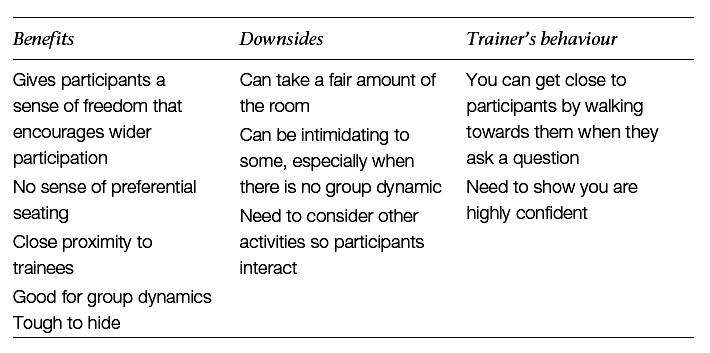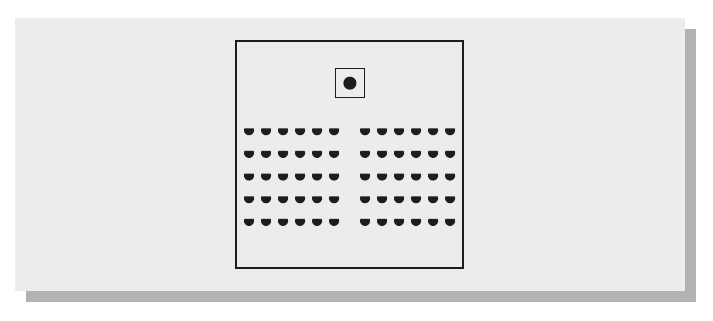The learning environment
Jeremy was looking around a primary school a few years ago. It had been open for only six months and he remembers being so impressed with both the building and what the teachers had done in the classrooms to help support the children’s learning. The classrooms had high ceilings and lots of glass, there was the latest technology at the teacher’s fingertips, the rooms were awash with colour, there were segmented learning areas and you could see everyone connected with the school loved the environment they had both inherited and created. All very different from the memory of his own education.
In contrast to this excellent learning environment, we have delivered business training courses in less than salubrious surroundings. The participants have had to endure:
- strip lighting;
- no natural light;
- temperatures that were either too hot or too cold;
- the absence of music because the sponsor thought it was ‘a little bit too far out for us’;
- uncomfortable chairs;
- no snacks;
- a poor milling area.
Jeremy remembers when he first became national training manager of a multi-billion pound company. He was expected to deliver the six-week induction course for all new managers and sales people in what he is still convinced today was a slightly oversized broom cupboard. Indeed all the inductees had to endure a low-class hotel a mile away from the company HQ. One of the first things he did was renegotiate the budget so he could invest in a better hotel and improved learning facilities. The issue is simple – do we really value training? If the answer is ‘yes’ then we need to pay attention to the learning environment and demonstrate that we really value people and trust that training can make a difference.
Have you ever been on a training course when you or another participant were patronised by the trainer or you started feeling as though you were being treated like an idiot. Or perhaps you remember feeling as though you were unable to ask questions or challenge the trainer’s view?
The learning environment really does matter and it is something which we can influence. Establishing an environment conducive to learning is a critical aspect of starting a training session off on the right foot. Creating a positive learning environment is a small investment that can have a tremendous impact on learning. As Nancy Kline writes in her book Time to Think: Listening to ignite the human mind (1998, Ward Lock):
Create a particular environment and people will think for themselves. It is that simple.
What do we mean by the learning environment?
The environment includes the physical space, the tools and materials used throughout the training session, and also includes the emotional space created by people in the room. The trainer creates an environment where everyone is heard, gets to learn their way, shares what they have learned and is able to speak freely.
We are not including here the wider learning environment back in the organisation. In this chapter we will be majoring on the physical space that anchors the training. In subsequent chapters we explore other aspects that contribute to what has been described as an accelerated learning environment.
If the environment is restrictive or dull, or the trainer does not help generate the right positive attitude to the event, the learning becomes arduous despite how well it is designed or presented. If the environment is inviting and energetic, it makes the learning experience much more pleasant, and learning and change are more likely to happen. It’s simple – creating the right learning environment will in all cases help the participants learn more easily. Many participants, for a whole host of reasons, may be a little apprehensive about attending a training session. The least we can do is ensure that participants walk into a relaxed atmosphere and an environment that is welcoming.
We were invited to an open programme in 2012 run by Ed Lamont of Next Action. We were there to observe Ed and find out why he has such a great reputation as a trainer. What struck us immediately was that this training organisation had grasped the importance of the environment. The content and delivery of the seminar was excellent. Both these elements were supported by:
- a team of people welcoming you;
- an upmarket hotel that reflected the brand;
- a large room with plenty of space for everyone;
- innovative supporting materials that reflected some of the key themes of the session;
- superb lunch, commented on by many of the delegates;
- a resources table that engaged you to look further into the subject.
Researchers have discovered that many things stimulate learners’ brains during training events. Key among these is the environment in which learning takes place. We are sure you want your learners to achieve their maximum learning potential. If so, create a learning environment in which you guarantee that everything that they will encounter from the time they enter until the time they leave is focused on the accomplishment of your and their learning objectives. So many training spaces encase people in sterile environments devoid of natural light. This often has a highly negative impact on the spirit, health and learning ability of participants.
OBJECTIVE RESEARCH
Dr Marion Diamond’s research at UC Berkeley has demonstrated how different kinds of environmental input (enriched or impoverished) can alter the structure of the rat’s cerebral cortex and consequently its behaviour.
The results of her research showed that enriched environments can increase the dimensions of the cellular constituents of the cortex at any age from prenatal to extremely old age.
In a seven-year research study, Dr Diamond provided statistically significant anatomical differences in the cerebral cortex of male and female rats throughout their laboratory lifetime, from birth to old age. She placed rats in a super-stimulating environment, complete with swings, ladders, treadmills, toys of all kinds – and other rats. Other rats were housed in bare cages, alone, and devoid of stimuli.
The rats in the high-stimulus environment lived longer, surviving until the age of three – the rat equivalent of 90 human years. The results proved that their brains increased in size. The rats that lived in bare cages stagnated and died younger. Their brains had fewer cellular connections.
More research and evidence is discovered daily that humans respond the same way. High stimulus environments create more brain cell connections and lead to longer and often fuller lives.
How can we use this information?
We need to pay attention to something that in most cases we have a high level of control over – the learning environment we create for our trainees.
Positive emotions accelerate learning. Create a positive and supportive learning environment and the learning is more likely to stick.
So what do we really need to pay attention to with regard to the physical learning environment?
Here is a grid that captures some of the key aspects of creating and managing the actual space to ensure it is conducive to learning:

Here are our top 11 tips for producing materials that truly focus on the audience in mind:
- Ensure all material links to business outcomes and complements the content of your training session.
- Utilise all the senses if you can.
- Avoid printing huge amounts of supporting material if you are hardly going to refer to it during your session. Better to send it via email, give it out on USB sticks or upload it onto an intranet.
- Make sure all of it is visually appealing.
- If you are going to print, use the material during your session.
- Make sure the design and approach fits the company culture (we have a few clients who are very particular about branding and image).
- Include relevant cases/books/PDFs, etc. to encourage further reading and reflection.
- If you are using a slide show and have printed this out for the trainees, give these out at the end, not the beginning. No printed slide show looks that exciting.
- Get feedback during and after the programme to elicit what the participants really think about the materials.
- Ensure there is paper available and encourage participants to write notes – this aids their learning.
- Remember to signpost those things that you cover which are not included in the supporting materials.
Arrangements for seating
Often the seating arrangements for a training session are decided by default or trainer preference is ignored and arrangements are decided at the last minute. Yet seating is a detail that is worth considering because how the audience sits will influence their level of interaction with you and the rest of the group. Seating arrangements tell us a lot about how the training will be conducted – formal or informal, creative or instructional, centralised or decentralised, and perhaps threatening or non-threatening. It needs to be part of our planning checklist. Sometimes we have little control over this aspect. Perhaps we are working in an auditorium with fixed seating or the boardroom has a solid table which is immovable. Most times, though, we do have a choice and we can move the tables and chairs around to suit our audience and the objectives of the session. Preferred patterns of seating are affected by trainer, purpose, type of activities used in the session, tradition and culture. What options are there for setting out the room in terms of chairs and tables? What do you want to achieve with your seating arrangements? Think carefully about your own visibility, the acoustics, the audience preference, comfort and the space available. It may be of course that there is a formal arrangement initially and this is changed several times because of the activities you are running during the workshop. Here are some of the various options with a quick assessment of the benefits and downsides.
No tables

Classroom
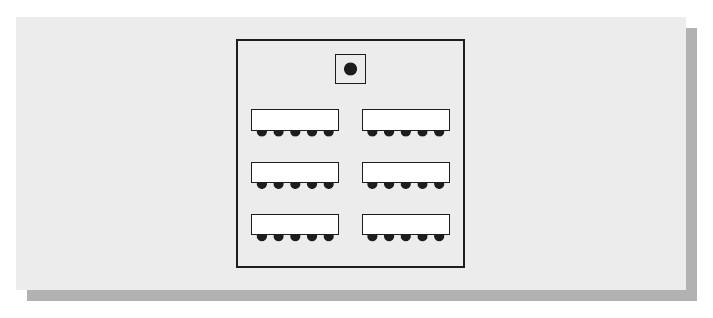

U-shaped format

Boardroom format
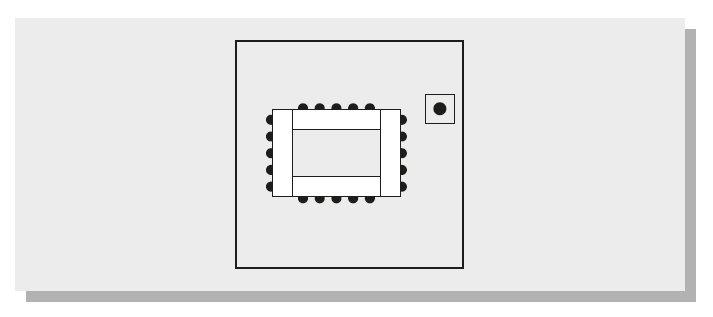
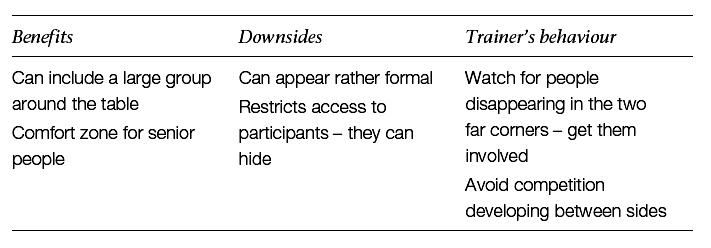
Cabaret format


Theatre format
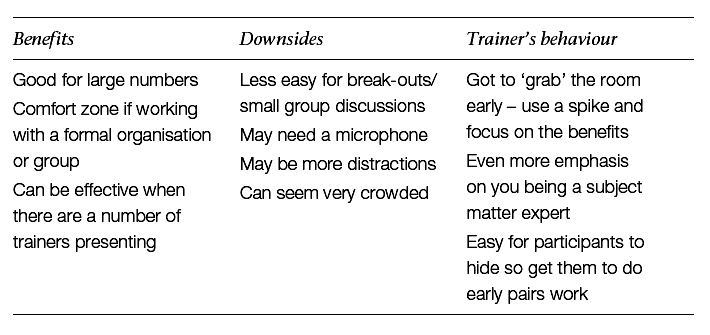
Fishbowl format

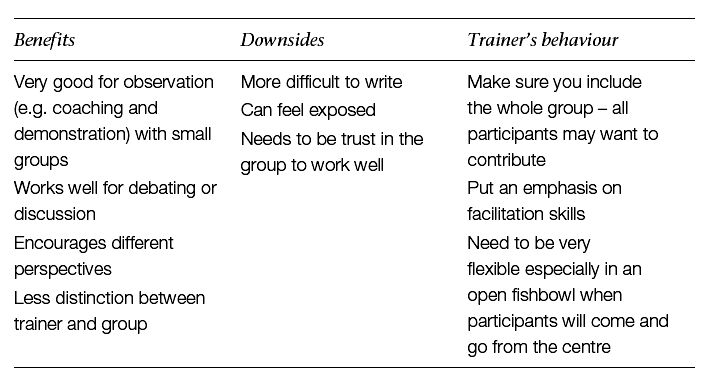
Often the best learning environments (see the Møller case study later) allow you the luxury of creating a unique space that will combine many elements. For example:
- theatre style for lecture;
- resource centre;
- working group/project area;
- creative space.
This can prove to be a real collaborative learning environment.
How to operate in a room that is not great
In the real world, you may not get the room of your dreams. What can you do if you are faced with a poor physical environment? Here are some ideas:
- Lobby in advance, as far as possible, to get a room that reflects what you want to achieve.
- Focus on what you can control – you can still play music, put up posters, use flipchart pages creatively.
- If there is no natural sunlight, the energy may well drop after a few hours. Ensure that you pay attention to what you are seeing in the room and take more breaks.
- Is there an opportunity of finding another space somewhere else, where some of the activities can take place?
- If you have had to put up with a disappointing room then speak to the delegates and get them to mention it in the evaluation process. Also, explain to the business sponsor how the environment has affected the course.
An example of good practice
We spend a lot of our time travelling and delivering all over the UK and the world. We have delivered in a variety of locations – some good and some indifferent. We wanted to share with you what is possible in the best learning environments. We chose The Møller Centre because we always enjoy delivering workshops there and it is, unquestionably, an example of good practice. In this learning environment there is a relentless pursuit of outstanding client service and an openness to the idea of continuous improvement.
A CASE STUDY: THE MØLLER CENTRE
Name: The Møller Centre – a purpose built executive training centre.
Location: Churchill College, University of Cambridge.
History: Opened in 1992 with a vision to create a centre of excellence where links between commerce and Churchill College, University of Cambridge would be forged to provide continuing professional development.
Mission: ‘Support our clients to acquire knowledge for professional development and personal and business success in an executive environment’.
Key elements of service:
- Designs and delivers bespoke executive education
- Access to leading academic practitioners from the University of Cambridge
- Can source the best trainers and coaches
- Creation of an outstanding learning environment
- Healthy, nutritional food and refreshments
- Capable, friendly staff with a commitment to providing fantastic customer service
- Comfortable, quality accommodation
Key features of the learning environment:
Here are some of the elements we have noticed as both trainers and delegates:
- Training rooms can create a collaborative learning environment and these are designed for learning and development only. They enhance innovative and creative thinking and use the latest technology to support learning
- Their training rooms are designed to make the most of natural daylight – this gives the delegates a more natural environment in which to work, which leads to better concentration
- Technological innovations to support learning include: whiteboards, magnetic walls, hyper tiles, built-in projection facilities, air conditioning, partition walls for flexible learning space and adaptable furniture. These are featured in every meeting room as standard
- Dedicated business centre available all day and free access to the internet
- ‘Milling’ space outside meeting rooms dedicated to networking – allows delegates to mingle with each other and extend the learning discussion outside the training room and build relationships
- Danish designed furniture – ergonomically designed chairs provide comfort and support for clients and are stylish and inspiring
- The open space of the College’s 42-acre grounds with a gym and tennis courts for exercise offer tranquillity and relaxation
- Space for team building – outdoor space to allow experiential learning or team building activities gives delegates the opportunity to explore new ways of learning without feeling restricted to the training room
- The lunches and dinner provided are full of variety and created with the understanding both of ‘brain food’ and that too much heavy food can make people feel sluggish and unable to fully focus. Water provided and refreshed regularly in the meeting room to keep delegates hydrated
Results
What do clients and external accreditation bodies make of The Møller Centre? It can boast some impressive results:
- 95% customer satisfaction rate (BDRC Continental Venue Verdict)
- Best Companies to Work For – two star accreditation for 2013
- Awards from:
- Queen’s Award for Enterprise: International Trade
- Best Residential Venue: Conference Centres of Excellence
- Best UK Management Training Centre: Meetings & Incentive Travel awards 2012, and Best Conference and Banqueting Staff 2012
Client satisfaction: ‘The Møller Centre combines state of the art facilities with world-class customer service. The staff are never satisfied, continually improving the service at the slightest suggestion.’ Ernst & Young LLP
Summary
The learning environment means both the physical and emotional space created to support the training. We need to pay attention to this because there is plenty of research evidence that a good environment has a huge impact on motivation, enjoyment and learning.
Here is what to focus on:
- Use your influence to get the room you want.
- The basics include having natural sunlight, a thermostat you can control, and refreshments readily available.
- Create a multi-sensory experience (toys, flipcharts, appropriate music).
- Ensure all supporting materials really add value to your clients – the participants.
- Use slides sparingly and only to support the key messages. Make sure they do not take over and become the central focus of the training.
- Flipcharts can really bring a training alive.
- Choose a room set up that reflects audience size and intentions.
- Think about what you can control if faced with delivering in a poor space.


